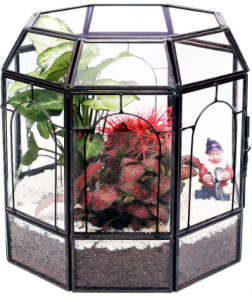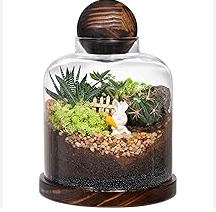Large Terrarium
In the world of interior design and home decoration, the allure of nature has always held a special place. The idea of bringing the outdoors inside has evolved over time, giving rise to innovative concepts that blend aesthetics with the wonders of the natural world. One such concept that has gained significant popularity is the large terrarium. These captivating indoor ecosystems encapsulate the essence of nature, allowing individuals to create their own miniature worlds teeming with life. In this exploration of the best large terrariums, we delve into their enchanting appeal, benefits, and how to create a mesmerizing terrarium that becomes a living piece of art.
The Enchanting Appeal of Large Terrariums: A Glimpse into Miniature Worlds
A large terrarium is essentially a glass container, often in the shape of a geometric globe or box, designed to house a self-sustaining ecosystem. It brings together elements like plants, soil, stones, and sometimes small animals, to create a harmonious balance within a confined space. These captivating glass gardens offer a unique way to appreciate the beauty of nature up close, providing an ever-changing tableau that can be admired and cared for within the comfort of one’s home.

Large terrariums have a mesmerizing appeal due to their ability to mimic the complexity of natural ecosystems on a miniature scale. They offer a glimpse into the delicate interactions between plant life, moisture, and the environment. From lush rainforests with cascading ferns to arid desert landscapes adorned with succulents, the possibilities are as diverse as the ecosystems they represent.
The Benefits of Large Terrariums: Greening Your Indoor Space
Beyond their aesthetic charm, large terrariums offer numerous benefits that contribute to the well-being of both the occupants and the environment they are placed in.
Low Maintenance: Large terrariums are designed to be self-sustaining ecosystems. They require minimal care, as the closed environment recycles moisture and nutrients, reducing the need for constant watering and fertilization.
Air Purification: Just like traditional potted plants, terrariums play a role in improving indoor air quality. Through the process of photosynthesis, plants release oxygen while absorbing carbon dioxide, creating a healthier atmosphere.

Stress Reduction: The presence of greenery and the act of nurturing a living ecosystem can have a calming effect on individuals. Large terrariums provide a soothing visual escape from the demands of daily life.
Unique Decor: Terrariums serve as captivating decor pieces, adding an element of elegance and nature to interior spaces. Their diversity in design allows for customization to suit various aesthetics.
Educational Value: Large terrariums provide an opportunity to learn about the delicate balance of ecosystems, the water cycle, and plant biology. They can be excellent educational tools for children and adults alike.
Creating Your Own Indoor Oasis: Steps to Design a Captivating Large Terrarium
Designing a large terrarium is a rewarding endeavor that allows you to express your creativity while nurturing a miniature world. Here’s a step-by-step guide to help you create your very own indoor oasis:
Choose Your Container: Select a glass container that provides ample space for your plants to grow. Large glass jars, fish tanks, or purpose-built terrarium containers are popular choices.
Gather Materials: Collect the necessary materials, including potting soil, activated charcoal (for filtering), decorative stones or pebbles, and the plants you intend to include.
Layering: Begin with a layer of stones or pebbles at the bottom to aid in drainage. Add a thin layer of charcoal to prevent odors and mold growth.
Soil Placement: Place a layer of potting soil on top of the charcoal. The depth of this layer will depend on the size of your plants’ root systems.
Plant Arrangement: Carefully arrange your chosen plants within the soil. Consider the growth habits and sizes of the plants to create an aesthetically pleasing arrangement.
Decorative Elements: Enhance your terrarium’s visual appeal by adding decorative elements like small figurines, miniature pathways, or tiny structures.
Moisturize: Lightly water the plants after planting, ensuring not to overwater. The closed environment will retain moisture, reducing the need for frequent watering.
Placement and Care: Find an appropriate spot for your terrarium. Different plants have varying light requirements, so consider the location’s light intensity. Rotate the terrarium occasionally to ensure even growth.
Maintenance: While large terrariums are low-maintenance, some care is still needed. Trim plants if they outgrow the space, remove any dead foliage, and wipe down the glass to maintain clarity.
Observation: Take time to observe your terrarium as it evolves. Watch as plants grow, interact, and adapt to their environment. This living piece of art will provide ongoing beauty and inspiration.
Choosing the Best Large Terrarium: A Comprehensive Guide
A large terrarium can be a captivating addition to your home decor, offering a miniature ecosystem where plants thrive and flourish. However, selecting the right large terrarium requires careful consideration to ensure the health of its inhabitants and the visual appeal it brings to your space. This guide will walk you through the essential factors to consider when choosing the best large terrarium.
Purpose and Location:
Before purchasing a large terrarium, define its purpose. Will it be a focal point in your living room, a stunning office decoration, or a functional space for plant propagation? Once you’ve determined its purpose, choose an appropriate location based on lighting conditions and available space.
Size and Shape:
The size and shape of the terrarium should complement the designated space and match your aesthetic preferences. Consider the available area and the dimensions that would best suit the room. While larger terrariums provide more space for creativity, they also require more maintenance.
Material and Build Quality:
Terrariums are commonly made from glass or acrylic. Glass offers clarity but can be fragile, while acrylic is sturdier and more lightweight. Check for well-crafted seams, a solid base, and a securely fitting lid to ensure the terrarium’s longevity.
Lid and Accessibility:
The lid is crucial for maintaining the terrarium’s humidity and preventing dust and debris from entering. Look for a lid that fits snugly and is easy to lift for maintenance tasks like watering and plant grooming.
Ventilation:
Proper airflow is essential for preventing mold and maintaining a healthy environment. Choose a terrarium with adjustable ventilation, such as small vents or gaps, to allow controlled air circulation.
Lighting:
Different plants have varying light requirements. If your terrarium will house plants, ensure it provides access to the right amount and type of light. Consider placing the terrarium near a window or providing artificial lighting if necessary.
Plant Compatibility:
If you plan to include live plants, research the species you want to incorporate. Some plants thrive in enclosed environments, while others might outgrow the space quickly. Select plants that have similar light, humidity, and temperature needs.
Maintenance:
Large terrariums demand regular care. Be honest with yourself about the time you can dedicate to maintenance tasks such as pruning, watering, and cleaning. An overly complex terrarium might become overwhelming if you have a busy schedule.
Aesthetic Elements:
Choose a terrarium that resonates with your design preferences. Some terrariums come with built-in decorations like rocks, sand, or miniature figurines. Consider these elements to ensure a visually appealing and harmonious composition.
Budget:
Terrarium prices can vary greatly based on size, material, and design. Set a budget that aligns with your expectations and explore options within that range.
Conclusion: A Window to Nature’s Wonders
Large terrariums represent more than just a decorative piece; they encapsulate the beauty and complexity of nature within a confined space. With their enchanting appeal and numerous benefits, they serve as a bridge between the natural world and our indoor environments. Whether you’re a nature enthusiast, a homeowner looking for unique decor, or someone seeking a peaceful escape, creating a large terrarium can be a fulfilling and captivating journey. So, venture into the world of glass gardens, and uncover the joys of nurturing your own miniature ecosystem—a living testament to the wonders of the Earth.
FAQs about the Best Large Terrarium
What is considered the best size for a large terrarium?
The ideal size for a large terrarium can vary based on the type of plants or animals you intend to house. Generally, a terrarium with dimensions around 24 inches in length, 18 inches in width, and 18 inches in height is a good starting point. However, the specific needs of your plants or animals should guide your decision on the appropriate size.
What are some key features to look for in the best large terrarium?
When choosing the best large terrarium, consider features such as adequate ventilation, accessibility (front-opening vs. top-opening), material quality (glass or acrylic), waterproof base, and the presence of built-in lighting and heating fixtures. Additionally, make sure it has provisions for managing humidity levels, as this is crucial for many terrarium inhabitants.
Can you recommend some plants suitable for a large terrarium?
Several plant species thrive in large terrariums. Some popular options include ferns, pothos, snake plants, air plants, and small orchid varieties. When selecting plants, take into account their growth habits, light requirements, and compatibility with the chosen terrarium size. Mixing plants with different height and leaf textures can create an aesthetically pleasing and balanced environment.
How do I maintain the environment within the large terrarium?
Maintaining a suitable environment involves regulating temperature, humidity, light, and ventilation. Use a thermometer and hygrometer to monitor temperature and humidity levels. Depending on the plants and animals, you may need to adjust lighting duration and intensity. Regularly prune plants to prevent overgrowth, and be cautious of any signs of disease or pests. It’s also important to clean the terrarium’s glass or acrylic surfaces periodically to ensure clear viewing.
What types of animals can be housed in a large terrarium?
Large terrariums can accommodate a variety of reptiles, amphibians, and invertebrates. Some popular choices include crested geckos, ball pythons, chameleons, tree frogs, tarantulas, and certain types of turtles. However, it’s crucial to research the specific requirements of the animal you plan to house, including temperature, humidity, substrate, hiding spots, and proper lighting. Some animals may need larger enclosures as they grow, so be prepared to adjust the terrarium accordingly.
Remember that the “best” large terrarium ultimately depends on your specific goals, whether you’re creating a lush plant paradise or a habitat for captivating creatures. Always prioritize the well-being of the inhabitants and ensure that their needs are met within the chosen terrarium setup.
